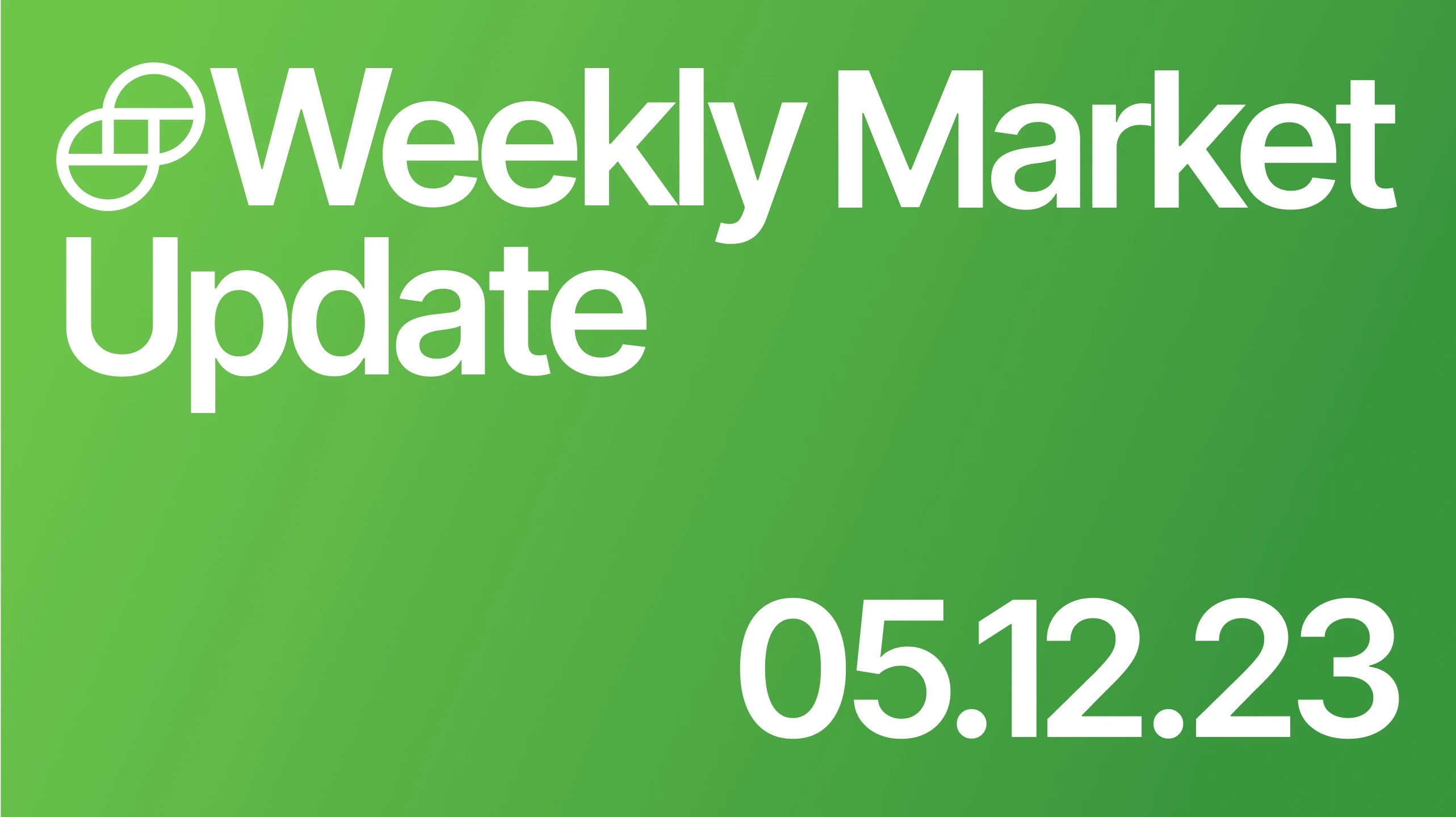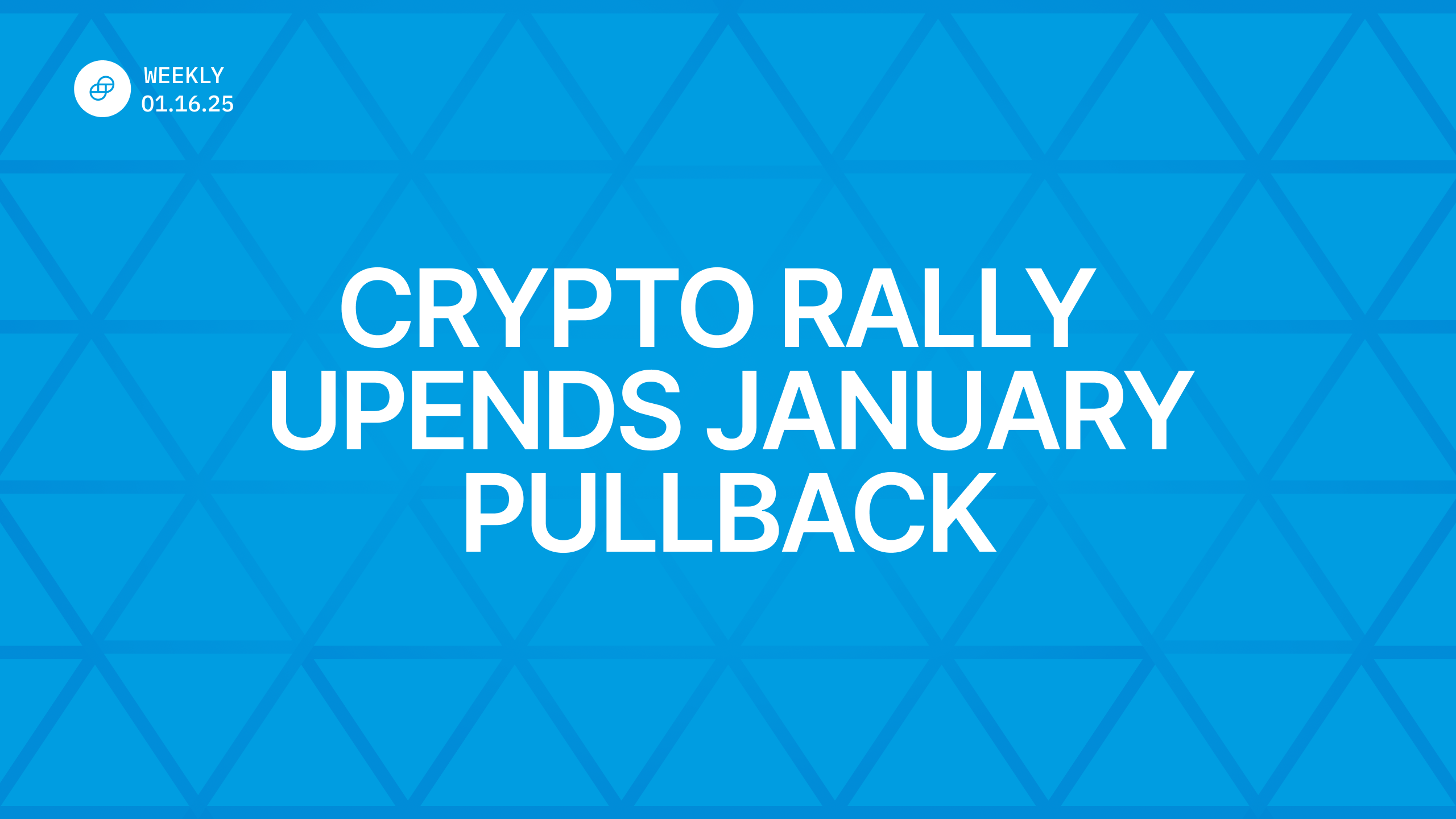Blog home
WEEKLY MARKET UPDATE
MAY 12, 2023
Weekly Market Update - Friday, May 12, 2023

Welcome to our Weekly Market Update.* Explore weekly crypto price movements, read a quick digest of notable market news, and dive into a crypto topic — this week we discuss DAOs.
Crypto Movers
Crypto News: What Happened This Week?
Crypto Topic of the Week: DAOs

Bitcoin (BTC) Price | ⬇️ 10.20% | $26,311
Ether (ETH) Price | ⬇️ 9.47% | $1,766
Liquity (LQTY) Price | ⬇️ 30.90% | $1.151
Injective (INJ) Price | ⬇️ 25.20% | $5.782
Fetch.ai (FET) Price | ⬇️ 23.70% | $0.235
Crypto prices as of Friday, May 12, 2023, at 11:50am ET. Percentages reflect trends over the past seven days. Check out the latest crypto prices here. All prices in USD.

Takeaways
- BRC-20 tokens and Ordinals transactions clogged up the Bitcoin network and transaction fees spiked to the highest since April 2021. BTC prices had a volatile week starting above $29k USD before plunging to around $26.5k USD by Friday.
- U.S. CPI came in-line with expectations, causing crypto to rally with risk assets. However, rumors of the U.S. government moving digital assets on-chain circulated once again, leading to a sell off led by BTC that has the asset class on its backfoot toward the end of the week.
- Crypto Twitter was buzzing this week with memecoins back in the spotlight led by PEPE’s meteoric rise. However, top new memecoins like PEPE, TURBO, and ORDI were well off their highs by the end of the week, declining by more than 50%.
- Tether (USDT) published eye-popping first quarter results, reporting $1.48b USD in net profits.
Noisy Week for Bitcoin Network With BRC-20 Tokens in the Spotlight
Bitcoin had an eventful week as the network was severely congested, caused by the minting of 14,000+ BRC-20 tokens. BRC-20 is a new fungible token standard for the Bitcoin network, analogous to ERC-20 tokens on Ethereum, which allows for the creation of new tokens stored on Bitcoin.
The rapidly growing interest in BRC-20 tokens was reflected in a spike in transaction fees on the Bitcoin network as users minting BRC-20 tokens took up over 50% of total transactions. As a result, the Bitcoin mempool, where unconfirmed transactions sit before inclusion in a new block, saw more than 450k transactions in the pipeline at one point. The congestion and high transaction fees led Binance to suspend Bitcoin withdrawals twice at the start of the week, before enabling BTC Lightning Network withdrawals to help tackle the issue.
Ordinals and BRC-20 tokens have been controversial in the Bitcoin community. Some users noted the increased use cases and potential for growing Layer-2 applications. Others, including a leading Bitcoin developer, suggested restricting or blocking their usage citing these transactions as spam. At a high-level, Ordinals are the Bitcoin equivalent of Ethereum-based NFTs.
U.S. Inflation Shows Signs of Abating
The U.S. Consumer Price Index (CPI) data for April came in at 4.9% on an annual basis, slightly below expectations. Released on Wednesday, the data showed a mild 0.4% monthly increase for April. The trends further reinforced investors' confidence that the Federal Reserve will pause interest rate hikes at its next policy meeting in June, and begin cutting rates later in the year.
Stocks closed slightly higher on Wednesday as a result, but the ongoing regional banking turmoil and the debt ceiling debate in Congress that appears to be hitting an impasse continue to weigh on investors.
Rollercoaster Week for BTC Price
The flurry of activity around Bitcoin created some negative headwinds that pushed the BTC price down from above $29k USD on Sunday toward the bottom of its two-month range around $27.5k USD on Wednesday morning.
Following a price recovery back above ~$28.3k USD following positive CPI data, BTC price suddenly declined later on Wednesday as rumors of the U.S. government selling 9.8k BTC began to circulate again, pushing the price as low as ~$26.8k USD. The rumors were quickly found to be false resulting in a short-term price rebound.
By the end of the week, the BTC price moved lower hovering around $26.5k USD by Friday morning. Liquidity conditions have worsened resulting in wider bid-ask spreads as it was reported two major market makers were paring back their U.S. crypto trading operations.
PEPE Revitalizes Crypto Twitter
Crypto Twitter received a boost this past week as memecoin mania took over once again, led by the frog-themed coin PEPE which brought with it a wave of FOMO across the space typically seen during bull markets. PEPE became the fastest-growing ERC-20 token in history as it took only 23 days from launch to cross the $1b USD market cap, moving into the top 50 tokens, and acquiring over 100k holders.
Another trending token was TURBO, a memecoin created using the popular AI tool ChatGPT with a budget of $69, which went on to hit a market cap of over $100m USD last weekend. Even Bitcoiners have got in on the action, with Bitcoin Ordinals and BRC-20 tokens seeing a rise in popularity. The total market cap of BRC-20 tokens surpassed $1b USD this week for the first time, with ORDI being the largest to date.
The memecoin mania, however, appears to be subsiding for the time being with a number of the biggest trending tokens since last weekend seeing greater than 50% drops from their peaks, including PEPE, TURBO, and ORDI mentioned above.
Tether Reports Strong First Quarter Profits
Stablecoin issuer Tether (USDT) reported $1.48b USD in net profits for the first quarter of the year and an increase of more than 20% in the tokens in circulation. As part of the report, Tether revealed the majority of its reserves are invested in U.S. Treasury Bills, but also holds 4% of the firm's reserves in gold and 2% in BTC. Tether has seen its market share of the stablecoin sector grow over the first quarter of the year following the minting of new BUSD being halted and the brief de-pegging of USDC during the collapse of Silicon Valley Bank.
-From the Gemini Trading Desk

Decentralized Autonomous Organizations (DAOs)
The dynamic crypto ecosystem has redefined what is possible with modern finance, from democratizing the transfer of value to reframing how we think about governance in the digital world.
Decentralized autonomous organizations (DAOs) have played an important role in the growth of decentralized finance (DeFi), building crypto communities and disintermediating decision-making processes across the crypto ecosystem. This week we take a high-level view of DAOs and their main characteristics.
What is a DAO?
DAOs are blockchain-based cooperatives that are collectively owned by its members, with rules set and executed via smart contracts. They replace centralized management structures with a techno-democratic approach wherein decisions are voted upon by investor-stakeholders. DAOs are built on top of blockchains (often Ethereum) and their transactions are visible on the underlying blockchain protocol.
Dive deeper into what DAOs are here.
By circumventing the need for human intervention or centralized coordination, DAOs are often referred to as “trustless” systems. A DAO’s trustless decision-making framework is generally intended to help make governance accessible to everyone, rather than a select few.
In practice, DAO governing bodies oversee the allocation of protocol resources and ensure the long-term viability of the projects they support.
Learn more about DAO governance here.
While not every blockchain project utilizes a DAO, the growth of DeFi protocols has heightened the profile of blockchain governance, driving further investment and interest in decentralized governance. According to DeepDAO, DAOs oversee more than $21.5 billion USD in digital assets as of May 2023.
What are the main characteristics of DAOs?
Although some DAOs operate as independent protocols, the vast majority of them share the following characteristics:
- Tokenization: DAOs often use blockchain-based tokens to represent voting rights, with token holders able to participate in network governance.
- Self-enforcement: DAOs employ smart contracts that automate organizational rules. These smart contracts can greatly reduce — or even eliminate — the need for intermediaries that might compromise decentralized decision-making.
- Autonomous automatization: A single smart contract is only capable of handling simple transactions. DAO frameworks define a complex set of smart contracts that enable multi-party interactions — without human involvement.
- Decentralized infrastructure: Although DAOs use decentralized governance, the underlying network must also exist on distributed infrastructure. Without adequate decentralization, governance can be exploited by those with significant enough computing power.
- Transparent data: Blockchain immutability helps DAOs function successfully as decentralized governance mechanisms. Immutability allows protocols to communicate about organizational processes and data in a transparent way.
- Trust mechanism: Smart contract conditions and other protocol mechanisms codify a certain degree of trust into DAOs. As a result, a variety of agreements between network stakeholders can occur without involving third parties, creating what is known as a “trustless” system.
Read more about the origins of DAOs and an early DAO hack that shook the crypto world. DAOs come in many forms, read about investment, NFT, and exchange DAOs here.
See you next week. Onward and Upward!
Team Gemini
*This material is for informational purposes only and is not (i) an offer, or solicitation of an offer, to invest in, or to buy or sell, any interests or shares, or to participate in any investment or trading strategy, (ii) intended to provide accounting, legal, or tax advice, or investment recommendations, or (iii) an official statement of Gemini. Gemini, its affiliates and its employees do not make any representation or warranty, expressed or implied, as to accuracy or completeness of the information or any other information transmitted or made available. Buying, selling, and trading cryptocurrency involves risks, including the risk of losing all of the invested amount. Recipients should consult their advisors before making any investment decision. Any use, review, retransmission, distribution, or reproduction of these materials, in whole or in part, is strictly prohibited in any form without the express written approval of Gemini.
RELATED ARTICLES

COMPANY
JAN 22, 2025
Five Crypto Predictions for 2025

WEEKLY MARKET UPDATE
JAN 16, 2025
Crypto Rebounds After Inflation Cools More Than Expected, Blackrock Launches Canadian Spot Bitcoin ETF, and SEC Ramps Up Legal Actions

DERIVATIVES
JAN 15, 2025